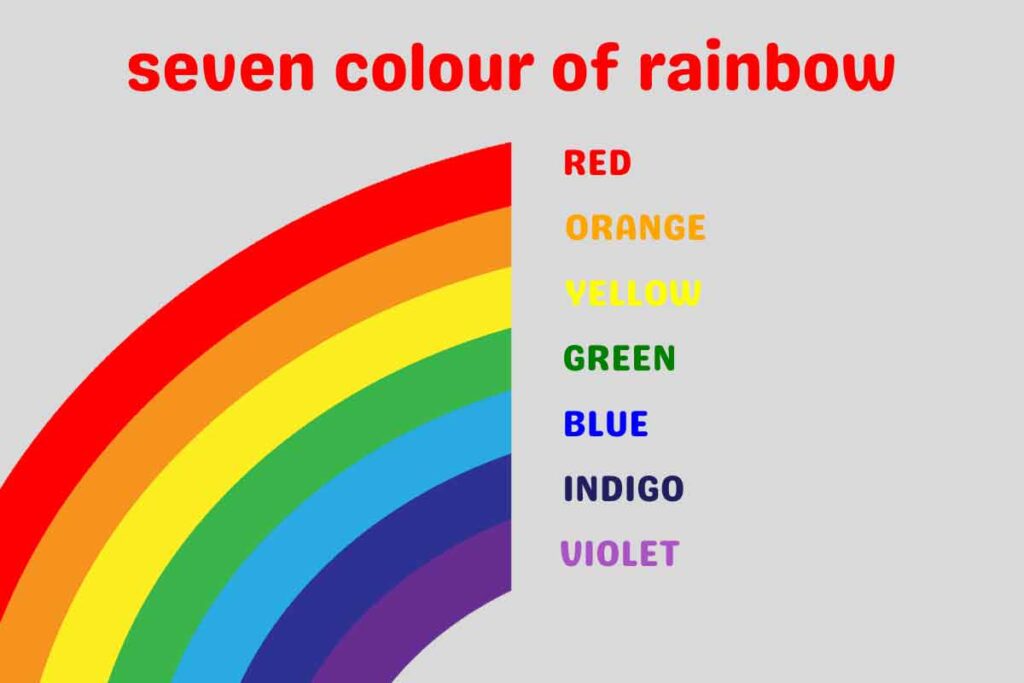Rainbows are a beautiful natural phenomenon that occurs when light is refracted, or bent, and dispersed in water droplets in the atmosphere. This refraction and dispersion of light causes the rainbow to appear with a range of colours that are both mesmerizing and fascinating. In this blog post, we will explore the colours of the rainbow and what they represent.
Rainbow colours are the seven colours that appear in the natural optical phenomenon of a rainbow, including red, orange, yellow, green, blue, indigo, and violet. The colours of the rainbow can be remembered using the acronym ROYGBIV.

Rainbow Color in Order
The order of the colors is determined by the wavelength of each color of light, with red having the longest wavelength and violet having the shortest wavelength. The colors blend into each other, creating a beautiful spectrum of colors in the sky.
| Order | Colour of Rainbow |
|---|---|
| 1 | Red |
| 2 | Orange |
| 3 | Yellow |
| 4 | Green |
| 5 | Blue |
| 6 | Indigo |
| 7 | Violet |
What is Rainbow Colours
Rainbow colors refer to the seven distinct colors of light that appear in a natural optical phenomenon known as a rainbow. These colors are red, orange, yellow, green, blue, indigo, and violet. A rainbow is created when sunlight is refracted (bent) and dispersed (spread out) in water droplets in the atmosphere, which causes the colors to appear in a specific order. The colors of the rainbow can be remembered using the acronym ROYGBIV, which stands for red, orange, yellow, green, blue, indigo, and violet.
7 Colours of the Rainbow
The rainbow is composed of seven distinct colours, which are red, orange, yellow, green, blue, indigo, and violet. These colours are arranged in a specific order, with red at the top and violet at the bottom. The colours of the rainbow can also be remembered using the acronym ROYGBIV.
The Colours of the Rainbow
Red is the first colour in the rainbow and is associated with passion, energy, and power. It is often used to represent love, desire, and anger. In nature, red is associated with fire and heat, and it can be seen in the sunset, flowers, and many fruits.
Orange is the second colour in the rainbow and is associated with warmth, enthusiasm, and happiness. It is often used to represent creativity, success, and optimism. In nature, orange is associated with the sunrise, autumn leaves, and many fruits such as oranges, mangoes, and peaches.
Yellow is the third colour in the rainbow and is associated with sunshine, joy, and positivity. It is often used to represent happiness, intellect, and energy. In nature, yellow is associated with the sun, flowers such as daffodils and sunflowers, and many fruits such as lemons and bananas.
Green is the fourth colour in the rainbow and is associated with growth, harmony, and balance. It is often used to represent nature, healing, and stability. In nature, green is associated with plants, trees, and grass.
Blue is the fifth colour in the rainbow and is associated with peace, tranquility, and stability. It is often used to represent calmness, loyalty, and trust. In nature, blue is associated with the sky, the ocean, and many flowers such as bluebells and forget-me-nots.
Indigo is the sixth colour in the rainbow and is associated with intuition, spirituality, and insight. It is often used to represent wisdom, perception, and understanding. In nature, indigo can be seen in the sky during a sunset or sunrise and in some flowers such as irises.
Violet is the seventh and final colour in the rainbow and is associated with creativity, inspiration, and imagination. It is often used to represent elegance, luxury, and royalty. In nature, violet is associated with flowers such as violets, lavender, and lilacs.
In addition to their individual associations, the colours of the rainbow can also be combined to represent various meanings. For example, red and yellow can represent excitement and warmth, while blue and green can represent harmony and balance.

